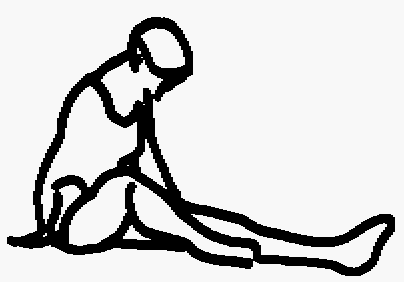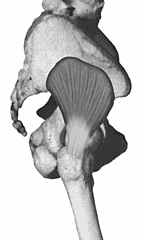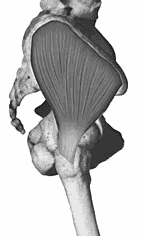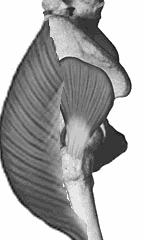|
|
|---|
Gluteus medius and minimus Stretch:- Start Position
- Sit on the ground. Keep your left leg straight out in front, and rest the sole
of your right foot against your left knee.
- Keep your hip, torso and face square, and make sure that your left knee cap
is pointing directly up to the ceiling.
- Scapulas anchored and back long.
Gluteus medius and minimus Stretch:- Action
- Breathe in, and zip and hollow.
- (Breathing out): lengthen up through the spine, and curl your spine forward, starting
with your neck, and working down to your lumbar spine. Do not twist over one leg, but stay in the centre.
- Take four wide full breaths in this position. Long neck, chin gently tucked, and scapulas anchored.
- Let your arms rest gently in front, with palms up.
- (Breathing out): zip, hollow, and rebuild your spine, uncoiling fro the hip up.
- Twice both sides.
Comment:
This exercise stretches the Gluteus minimus and anterior Gluteus medius.
You should feel a tightness along the side of your pelvis. You may feel an wooden ache down the side of your leg.
This ache is not sciatica but rather, pseudo-sciatica and is caused by trigger points in the Gluteus minimus muscle.
You can massage the pain and discomfort away.
(ruptured gluteus medius, ruptured gluteus minimus, tendinopathy, Scroll right>>>>....)
|
The Sitting Gluteus medius and minimus Stretch -
Start Position
 Action
Action

Watch Points
- Do not pull on the neck and head. Think rather of gently cradling!
- Keep the upper chest open.
© Bruce Thomson, EasyVigour Project
|
Diagrams:
Gluteus minimus

Gluteus medius

Gluteus maximus with its tendinous portion cut away to show the Gluteus minimus: The
top portion of Gluteus maximus is able to take some of the workload off the Gluteus minimus.

|
This web page needs re-writing.
If you need help with your pseudo-sciatica then drop me a line and I will do my best to help you:
Contact
Author
|
Pseudo- sciatica due to Gluteus minimus trigger points:-
The Gluteus medius and minimus are the side struts for the pelvis.
They stabilize the pelvis when you stand on one leg. If your core muscles (abdominals) and back muscles
(Quad lumborum and Gluteus maximus) are not strong; also if your balance is not good, these muscles
become the muscles of last resort for stabilization and are easily overloaded and break down.
Trigger points are common in the Gluteus minimus and transmit pain
(feels like the leg is wooden, aching and tingling)
all the way
down the side of the leg - which is extremely misleading, but that is the nature of trigger points!
You will feel this ache all the way down the leg when you do the Gluteus minimus stretch.
Even doctors may misdiagnose this as sciatica (sciatic nerve pain). Help is at hand in the form of
trigger point massage, the stretch on this page and "core exercises to get the above mentioned muscles
to fire up and take on their fair share of the hip satbility workload.
(More info...Triggerpoint Therapy Workbook).
if you are patient and persistent the results are usually very good.
Reference
- Shirley A Sahrmann: Diagnosis and Treatment of Movement Impairment Syndromes;
Publ. Mosby 2002
- The Official Body Control Pilates Manual Available from: http://www.bodycontrol.co.uk/
- LaBan, Myron M. MD, MMSc; Weir, Susan K. MD; Taylor, Ronald S. MD:
'Bald Trochanter' Spontaneous Rupture of the Conjoined Tendons of the Gluteus
Medius and Minimus Presenting as a Trochanteric Bursitis.
American Journal of Physical Medicine & Rehabilitation. 83(10):806-809, October 2004.
|
 Action
Action


